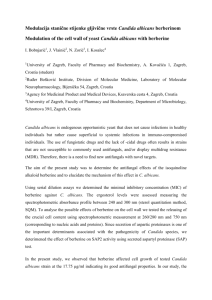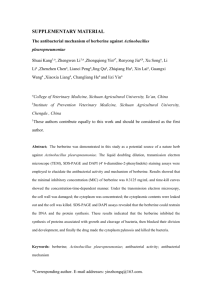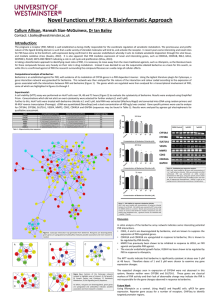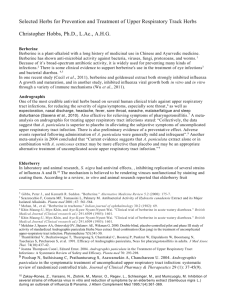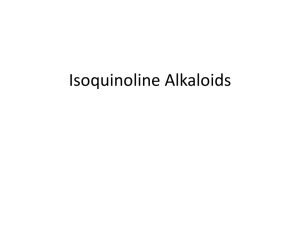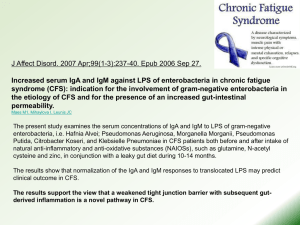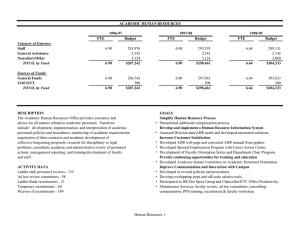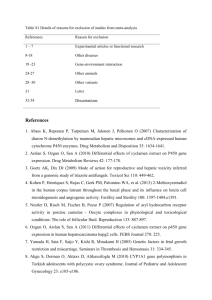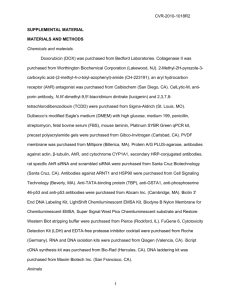Activation of the aryl hydrocarbon receptor by berberine
advertisement
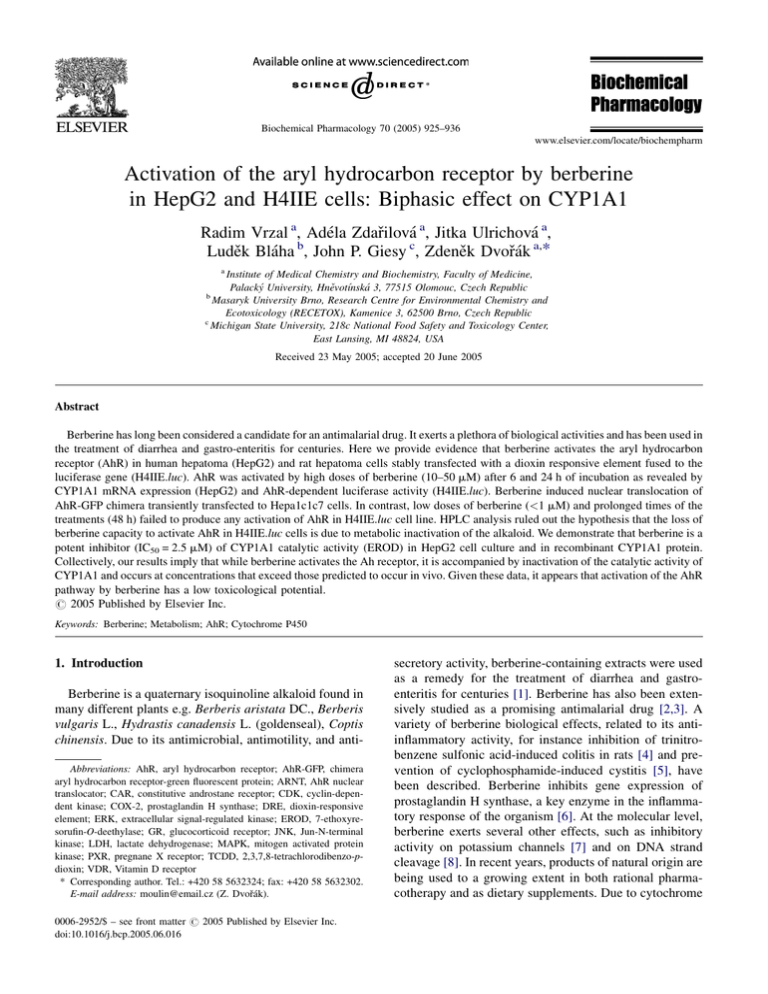
Biochemical Pharmacology 70 (2005) 925–936 www.elsevier.com/locate/biochempharm Activation of the aryl hydrocarbon receptor by berberine in HepG2 and H4IIE cells: Biphasic effect on CYP1A1 Radim Vrzal a, Adéla Zdařilová a, Jitka Ulrichová a, Luděk Bláha b, John P. Giesy c, Zdeněk Dvořák a,* a Institute of Medical Chemistry and Biochemistry, Faculty of Medicine, Palacký University, Hněvotı́nská 3, 77515 Olomouc, Czech Republic b Masaryk University Brno, Research Centre for Environmental Chemistry and Ecotoxicology (RECETOX), Kamenice 3, 62500 Brno, Czech Republic c Michigan State University, 218c National Food Safety and Toxicology Center, East Lansing, MI 48824, USA Received 23 May 2005; accepted 20 June 2005 Abstract Berberine has long been considered a candidate for an antimalarial drug. It exerts a plethora of biological activities and has been used in the treatment of diarrhea and gastro-enteritis for centuries. Here we provide evidence that berberine activates the aryl hydrocarbon receptor (AhR) in human hepatoma (HepG2) and rat hepatoma cells stably transfected with a dioxin responsive element fused to the luciferase gene (H4IIE.luc). AhR was activated by high doses of berberine (10–50 mM) after 6 and 24 h of incubation as revealed by CYP1A1 mRNA expression (HepG2) and AhR-dependent luciferase activity (H4IIE.luc). Berberine induced nuclear translocation of AhR-GFP chimera transiently transfected to Hepa1c1c7 cells. In contrast, low doses of berberine (<1 mM) and prolonged times of the treatments (48 h) failed to produce any activation of AhR in H4IIE.luc cell line. HPLC analysis ruled out the hypothesis that the loss of berberine capacity to activate AhR in H4IIE.luc cells is due to metabolic inactivation of the alkaloid. We demonstrate that berberine is a potent inhibitor (IC50 = 2.5 mM) of CYP1A1 catalytic activity (EROD) in HepG2 cell culture and in recombinant CYP1A1 protein. Collectively, our results imply that while berberine activates the Ah receptor, it is accompanied by inactivation of the catalytic activity of CYP1A1 and occurs at concentrations that exceed those predicted to occur in vivo. Given these data, it appears that activation of the AhR pathway by berberine has a low toxicological potential. # 2005 Published by Elsevier Inc. Keywords: Berberine; Metabolism; AhR; Cytochrome P450 1. Introduction Berberine is a quaternary isoquinoline alkaloid found in many different plants e.g. Berberis aristata DC., Berberis vulgaris L., Hydrastis canadensis L. (goldenseal), Coptis chinensis. Due to its antimicrobial, antimotility, and antiAbbreviations: AhR, aryl hydrocarbon receptor; AhR-GFP, chimera aryl hydrocarbon receptor-green fluorescent protein; ARNT, AhR nuclear translocator; CAR, constitutive androstane receptor; CDK, cyclin-dependent kinase; COX-2, prostaglandin H synthase; DRE, dioxin-responsive element; ERK, extracellular signal-regulated kinase; EROD, 7-ethoxyresorufin-O-deethylase; GR, glucocorticoid receptor; JNK, Jun-N-terminal kinase; LDH, lactate dehydrogenase; MAPK, mitogen activated protein kinase; PXR, pregnane X receptor; TCDD, 2,3,7,8-tetrachlorodibenzo-pdioxin; VDR, Vitamin D receptor * Corresponding author. Tel.: +420 58 5632324; fax: +420 58 5632302. E-mail address: moulin@email.cz (Z. Dvořák). 0006-2952/$ – see front matter # 2005 Published by Elsevier Inc. doi:10.1016/j.bcp.2005.06.016 secretory activity, berberine-containing extracts were used as a remedy for the treatment of diarrhea and gastroenteritis for centuries [1]. Berberine has also been extensively studied as a promising antimalarial drug [2,3]. A variety of berberine biological effects, related to its antiinflammatory activity, for instance inhibition of trinitrobenzene sulfonic acid-induced colitis in rats [4] and prevention of cyclophosphamide-induced cystitis [5], have been described. Berberine inhibits gene expression of prostaglandin H synthase, a key enzyme in the inflammatory response of the organism [6]. At the molecular level, berberine exerts several other effects, such as inhibitory activity on potassium channels [7] and on DNA strand cleavage [8]. In recent years, products of natural origin are being used to a growing extent in both rational pharmacotherapy and as dietary supplements. Due to cytochrome 926 R. Vrzal et al. / Biochemical Pharmacology 70 (2005) 925–936 P450 involvement in drug metabolism, interactions between natural compounds and the P450 system are of general interest. Berberine is no exception. Surprisingly, despite the voluminous data on berberine biological activity, there are only a limited number of studies dealing with the interactions of berberine and the cytochrome P450 system. One study on human hepatic microsomes has shown the inhibitory effect of berberine on CYP2D6 catalyzed bufuralol 10 -hydroxylation (IC50 = 45 mM), and on CYP3A4 catalyzed testosterone 6-b-hydroxylation (IC50 = 400 mM) [9]. Another refers to goldenseal tea inhibitory effect against several P450 isoforms [10]. A metabolic study on rats has demonstrated that berberine undergoes cytochrome P450 mediated O-demethylation, followed by glucuronidation and hepatobiliary excretion [11]. We have investigated the effect of berberine on CYP1A1, the enzyme involved in the activation of polycyclic aromatic hydrocarbons (benzo[a]pyrene) into ultimate carcinogens [12,13]. CYP1A1 is not expressed constitutively but is highly inducible in many organs including the liver, intestine and lung, by polycyclic aromatic hydrocarbons, polychlorinated biphenyls (dioxins), and other compounds [14]. Regarding drug metabolism, CYP1A1 is responsible for the metabolism of the leukotriene receptor antagonist verlukast [15]. Due to CYP1A1 involvement in chemically induced carcinogenesis, its inhibition may play a role in cancer prevention. An inhibitory effect was found for St. John’s wort extracts on CYP1A1 [16]; direct inhibition of CYP1A1 by transresveratrol, a polyphenolic compound supposedly responsible for ‘‘The French paradox’’ [17]. Although berberine has been shown to exert anti-tumor effects in colorectal cancer, it has not yet been determined whether this activity involves CYP1A1 [6]. In the work presented here we examined the effect of berberine on AhR-dependent induction of CYP1A1 in two cell lines, a human hepatoma cell line (HepG2) and rat hepatoma cell line (H4IIE) stably transfected with a dioxin-responsive element fused to the luciferase gene (DRE-LUC vector). The HepG2 cells were used to examine CYP1A1 catalytic activity (7-ethoxyresorufin-Odeethylase; EROD), CYP1A1 mRNA expression and CYP1A1 protein content and H4IIE.luc cells for AhRdependent luciferase activity. 2. Methods 2.1. Chemicals Dulbecco’s modified Eagle’s medium, minimal essential medium, fetal calf serum, penicillin, streptomycin, L-glutamine, non-essential amino acids, sodium pyruvate, NADPH, dicumarol, 7-ethoxyresorufin, berberine hemisulphate (C20H18NO4(1/2)SO4; MW 384.40; purity 95%), recombinant CYP1A1, and Kodak X-Omat AR photo- graphic film were purchased from Sigma Chemicals (St. Louis, MO). 2,3,7,8-Tetrachlorodibenzo-p-dioxin was purchased from Ultra Scientific (RI, USA). Secondary horseradish peroxidase conjugated antibody, and Western blotting luminol reagent were purchased from Santa Cruz Biotechnology (Santa Cruz, CA). Human liver microsomes were from the microsomal bank of The Institute of Medical Chemistry and Biochemistry, Faculty of Medicine, Palacky University, Olomouc, Czech Republic. HPLC grade acetonitrile for was purchased from Merck (Darmstadt, Germany). FuGENE 6 transfection reagent was obtained from Roche (Mannheim, Germany). All other chemicals were of the highest grade commercially available. 2.2. Cell cultures HepG2 cells: The human hepatoma cells HepG2 (ECACC No. 85011430) were grown in Dulbecco’s modified Eagle’s medium (DMEM)supplementedwith10%offetalcalfserum (FCS), streptomycin (100 U/mL), penicillin (100 mg/mL), Lglutamine (4 mM), non-essential amino acids and sodium pyruvate. H4IIE.luc cells: The rat hepatoma cells H4IIE.luc, were stably transfected with a luciferase reporter gene fused to the dioxin-responsive elements (pGduLuc 1.1. plasmid) as described elsewhere [18,19]. pGudLuc 1.1 plasmid contains MMTV fragment as well as 480 bp fragment isolated from the 50 -flanking region of the mouse CYP1A1 gene. The 480 bp fragment contains four DREs. The cells were cultured in minimal essential medium supplemented with 10% heatinactivated fetal calf serum. Cells were maintained at 37 8C in 5% CO2 humidified incubator. 2.3. Cytotoxicity assays HepG2 and H4IIE.luc cells were seeded on 24-well dishes at a density of 1 105 cells/well using appropriate culture media enriched with fetal calf serum (10%,v/v). Following 16 h of stabilization, the medium was exchanged for a serumfree medium and cells were treated for 1, 2, 3, 4, 6, 24, 48 and 72 h with berberine in concentrations of 0.0001–50 mM or with DMSO (vehicle) and 1% (v/v) Triton X-100. Lactate dehydrogenase (LDH) leakage into the medium (kit Promega) and MTT assay were measured as indicators of membrane damage and cell viability, respectively. The concentrations of berberine that caused no more than a 10% decrease in cell viability were considered as non-toxic for further experiments. 2.4. Measurement of CYP1A1 catalytic activity (EROD) in HepG2 cells HepG2 cells were seeded on 96-well dishes at a density of 2.4 104 cells/cm2 in DMEM supplemented with 10% FCS and stabilized for 24 h. Cells were then treated for 6, 24 and 48 h with berberine (BER; 0.001, 0.01, 0.1, 1, 10, 50 mM final concentration), and/or DMSO as a vehicle for R. Vrzal et al. / Biochemical Pharmacology 70 (2005) 925–936 control in the absence or in the presence of 2,3,7,8-tetrachlorodibenzo-p-dioxin (TCDD; final concentration 5 nM). Culture medium used for the treatments was enriched with 5% FCS. The catalytic activity of 7-ethoxyresorufin-O-deethylase (EROD) in cell cultures was measured as described elsewhere [20]. Briefly, monolayers were washed with PBS and the serum free medium containing 8 mM 7-ethoxyresorufin and 10 mM dicumarol (to inhibit cytosolic diaphorase) was applied to cells. Following 30 min of incubation at 37 8C, an aliquot of 75 mL of the medium was mixed with 125 mL of methanol and fluorescence was measured in 96-well plate with 530 nm excitation and 590 nm emission filters. The EROD formation was linear up to 60 min. The data were expressed either as the ratio of treated over control values (DMSO treated cells) or as the percentage of maximal induction (TCDD treated cells). 2.5. Enzyme kinetic on recombinant CYP1A1 protein Catalytic activity of CYP1A1 was measured according to the established method [21] adjusted to 96-well plate format. Berberine in a concentration range 0.001–100 mM was incubated with recombinant CYP1A1 protein (0.1 pmol/well) in 100 mL of HEPES buffer (0.1 M HEPES, pH 7.8) containing 10 mL of 7-ethoxyresorufin (3 mM final concentration). The reaction was initiated by the addition of 10 mL of NADPH (0.25 mM final concentration) and stopped by 125 mL methanol after 10 min. Fluorescence was measured with 530 nm excitation and 580 nm emission filters. The assay was linear over the enzyme concentrations used and up to 30 min of the incubation in our experimental setup. 2.6. Detection of CYP1A1 protein HepG2 cells were seeded on Petri dishes (100 mm i.d.) at a density of 2.4 104 cells/cm2 using DMEM medium supplemented with 10% FCS. Following 24 h of stabilization, cells were treated 24, 48, and 72 h with berberine (BER; 0.01, 0.1, 1, 10, 50 mM final concentrations), and/or DMSO as vehicle for control in the absence or in the presence of 2,3,7,8-tetrachlorodibenzo-p-dioxin (TCDD; final concentration 5 nM). The compounds tested were added every 24 h during regular medium exchange. Treatments were carried out in a medium supplemented with 5% FCS. Human liver microsomes were isolated according to a protocol described elsewhere [22]. The protein content of microsomes was determined by the biscinchoninic acid method [23]. SDS-PAGE gels were run on a BIORAD Power-PAC 3000 apparatus following a general procedure [24]. Protein transfer onto polyvinylidene difluoride (PVDF) membrane was carried out as described [25]. The membrane was stained with PonceauS for control of transfer and then saturated with 8% non-fat dried milk 2 h at room temperature. Blots were probed with primary 927 antibody against human CYP1A1 (CYP1A1 (G-18) goat polyclonal IgG; dilution 1/500) purchased from Santa Cruz Biotechnology (Santa Cruz, CA). Chemiluminescence detection was performed using horseradish peroxidase conjugated secondary antibody and Western blotting luminol reagent (Santa Cruz Biotechnology, Santa Cruz, CA). 2.7. CYP1A1mRNA determination HepG2 cells were plated on six-well dishes at a density of 2.4 104 cells/cm2 using DMEM medium supplemented with 10% FCS. Following 24 h of stabilization, cells were treated 6 and 24 h with berberine (BER; 0.1, 1, 10, 50 mM final concentrations) and/or DMSO as vehicle for control in the presence or absence of 2,3,7,8-tetrachlorodibenzo-pdioxin (TCDD; final concentration 5 nM). High Pure RNA Isolation Kit; Real time PCR cycler LightCycler; First Strand cDNA Synthesis Kit for RT-PCR (AMV) and LightCycler FastStart DNA MasterPLUS SYBR Green I were purchased from Roche Diagnostic GmbH, Mannheim, Germany. Primers were purchased from Metabion international AG (Martinsried, Germany). cDNAwas synthesized with primer Oligo-p(dT)15, aliquoted, and stored at 80 8C. PCR reactions were performed using following conditions—CYP1A1 primers [26]: forward 50 -TTCCGACACTCTTCCTTCGT30 ; reverse 50 -ATGGTTAGCCCATAGATGGG-30 ; 10 min/ 95 8C, 30 cycles 95 8C/10 s, 65 ! 58 8C 10 s, 72 8C/16 s. GAPDH primers [27]: forward 50 -ACCACAGTCCATGCCATCAC-30 ; reverse 50 -TCCACCACCATGTTGCTGTA30 ; 10 min/95 8C, 30 cycles 95 8C/15 s, 54 8C/5 s, 72 8C/ 20 s. The purity of the product was checked by electrophoresis. The measurements were performed in duplicate. Relative expression of CYP1A1 mRNA was normalized on glyceraldehyde-3-phosphate dehydrogenase (GAPDH) as housekeeping gene. 2.8. AhR-dependent luciferase activity in H4IIE.luc cells Rat hepatoma cells stably transfected with a luciferase reporter gene fused to the dioxin-responsive enhancers (H4IIE.luc) were seeded on 96-well culture plates and grown to 90–100% confluence. The cells were treated 6, 24 and 48 h with berberine (BER; 0.001, 0.01, 0.1, 1, 10, 50 mM), and/or DMSO as vehicle for control in the presence or absence of 2,3,7,8-tetrachlorodibenzo-p-dioxin (TCDD; final concentration 5 nM). The luciferase activity was measured on a luminometer TECAN GENios using the Luciferase Monitoring Kit (Promega). 2.9. Berberine metabolism in HepG2 and H4IIE cells The cells were plated on Petri dishes (100 mm i.d.) at a density of 2.4 104 cells/cm2 using culture medium supplemented with 10% FCS. Following a 24 h stabilization 928 R. Vrzal et al. / Biochemical Pharmacology 70 (2005) 925–936 period, the cells were incubated 0, 6, 24 and 48 h with berberine (BER; 50 mM final concentration). The culture medium was then collected together with the cells and the mixture was homogenized using repeated freeze/thaw cycles (80 8C) and sonication. Proteins were denatured by adding acetonitrile (70% (v/v) final concentration). The deproteined samples were diluted 10-fold in the mobile phase and subjected to HPLC separation. The analyses were carried out on Shimadzu Class VP (Japan), using LichroCART1 C18 reversed phase chromatographic column 250 mm 4 mm (i.d.); particle size 5 mM (Merck, Darmstadt, Germany). Samples were eluted in the mobile phase (acetonitrile:0.1 M phosphate:triethylamine 30:70:1; pH 2.9) using isocratic elution with a flow rate of 1 mL/min and the temperature 25 8C. Berberine detection was performed by RF-10A-XL fluorescence detector (Shimadzu, Japan), applying the wavelengths 327 nm for excitation and 577 nm for emission. Berberine hemisulphate (C20H18NO4(1/2)SO4; MW 384.40; purity 95%) was used as the standard (Sigma Chemicals, St. Louis, MO). The difference between the retention times of two consecutive analyses was lower than 0.6%. The data were processed using Shimadzu Class-VP software. 2.10. Ligand binding assay Ligand binding was performed by the modified procedure of Herr et al. [28]. A culture of murine hepatoma cells (Hepa-1c1c7) was washed twice with PBS, scraped in 1 mL of binding buffer/10 cm Petri dish, centrifuged and resuspended in 1 mL of binding buffer (5 mM Tris– HCl, pH 7.4; 5% glycerol; 1 mM EDTA; 10 mM Na2MoO6(2H2O); 2 mM b-mercaptoethanol). Cells were incubated for 10 min on ice, homogenized, centrifuged (35,000 rpm/4 8C/1 h; Ti 70.1 rotor), and the supernatant, the cytosolic fraction, was collected. Then 143.5 mL of the cytosol was mixed with 5 mL of [3H]-TCDD (final concentration 2 nM) alone or in combination with DMSO, 1 mM 3-methylcholanthrene, 10 and 50 mM berberine, and incubated overnight at 4 8C. Bulk of the free dioxin in 100 mL of the incubation mixture, was removed by gel filtration using Sephadex LH-20 (Pharmacia, Guyancourt, France). Thereafter 200 mL fractions were collected by sequential elution from the column and radioactivity present in each fraction was measured in a liquid scintillation counter Packard Tri-Carb 2100TR (Canberra Packard, Savigny-le-Temple, France). Dr. Gordon Hager (National Cancer Institute, Laboratory of Receptor Biology and Gene Expression, Bethesda, MD, USA). Cells were treated 1 h with berberine (BER; 50 mM final concentration), 2,3,7,8-tetrachlorodibenzo-p-dioxin (TCDD; final concentration 5 nM) and/or DMSO as vehicle for control. After the fixation of cells in formaldehyde, the AhR translocation was evaluated using fluorescent microscopy with a Leica DMRA microscope equipped with a 40 or 100 objective. 2.12. Statistics The results were expressed as means standard deviations. A Student’s t-test was applied to all analyses. All calculations were performed using MS Excel 2000. 3. Results 3.1. Cytotoxicity assays We first evaluated berberine cytotoxicity in the two cell lines selected for the study by MTT test, LDH leakage into culture medium, and neutral red incorporation into the cells. Berberine was tested at concentrations from 0.0001 to 50 mM each for 1, 2, 3, 4, 6, 24, 48 and 72 h. The concentrations of berberine that caused no more than a 10% decrease in cell viability were considered as non-toxic for further experiments. 3.2. Berberine effects on 7-ethoxyresorufin-Odeethylase activity in HepG2 cells At the beginning of our experiments, we used the measurement of 7-ethoxyresorufin-O-deethylase (EROD) activity for cursory examination of berberine influence on CYP1A1, the aryl hydrocarbon receptor (AhR) target gene. Basal EROD activity in HepG2 cells was slightly increased (approx. 50%) by 1 mM berberine (Fig. 1A). Treatment with TCDD caused 25–30-fold increase in CYP1A1 activity. Dioxin-inducible CYP1A1 catalytic activity was reduced by berberine in a dose-dependent manner (Fig. 1B). However, this assay does not allow us to distinguish whether the drop in CYP1A1 catalytic activity by berberine is due to the CYP1A1 enzyme activity inhibition or CYP1A1 gene down-regulation. 3.3. Berberine effect on human recombinant CYP1A1 2.11. AhR-GFP nuclear translocation in Hepa-1c1c7 cells Hepa-1c1c7 cells transiently transfected by lipofection (FuGENE 6) with chimera aryl hydrocarbon receptorgreen fluorescent protein (AhR-GFP) or with GFP alone were cultured 24 h using dishes with immersed glass cover-slips. AhR-GFP plasmid was a generous gift from To clarify the cause of the diminution of dioxin-inducible EROD activity in HepG2 cells by berberine, the kinetic of enzyme reaction was studied on human recombinant CYP1A1 protein. The results obtained from the measurements of EROD activity on recombinant CYP1A1 protein clearly affirm the concentration-dependent inhibition of the enzyme catalytic activity by berberine (Fig. 2). R. Vrzal et al. / Biochemical Pharmacology 70 (2005) 925–936 929 3.4. Berberine effect on CYP1A1 mRNA expression in HepG2 cells From a mechanistic point of view, the increase/decrease in the mRNA level in response to the stimuli serves as evidence that gene expression was triggered/silenced. Thus, we analyzed the levels of CYP1A1 mRNA in HepG2 cells in order to determine whether the inhibition of CYP1A1 catalytic activity by berberine was the sole reason for the decrease of dioxin-inducible EROD activity in HepG2 cells. Treatment of HepG2 cells with dioxin caused an incremental induction of CYP1A1 mRNA as compared to the control cells, the increase being approximately 5and 260-fold, for 6 and 24 h period, respectively (Fig. 3). Fig. 1. Effect of berberine on basal and dioxin-inducible 7-ethoxyresorufinO-deethylase activity in HepG2 cells. Culture was treated 48 h with berberine (BER; final concentrations 0.01, 0.1, 1 mM), and/or DMSO as vehicle for control in the absence (Panel A) or in the presence (Panel B) of 2,3,7,8-tetrachlorodibenzo-p-dioxin (TCDD; final concentration 5 nM). CYP1A1 activity (7-ethoxyresorufin-O-deethylase; EROD) was measured by fluorescence spectrophotometry as described in Section 2. Bar graphs represent the mean S.D. of five independent experiments. The capacity of berberine to suppress CYP1A1 activity in HepG2 cells (Fig. 1B) is proportionate to its inhibitory concentration IC50 found on recombinant CYP1A1 enzyme (IC50 = 2.5 mM). Hence, the decrease of dioxin-inducible EROD activity may be at least partly attributed to the inhibition of CYP1A1 catalytic activity by berberine. Fig. 2. Berberine effect on catalytic activity of recombinant human CYP1A1 protein. CYP1A1-mediated O-dealkylation of 7-ethoxyresorufin was measured on human recombinant CYP1A1 protein in the presence of varying concentrations of berberine. A 100% activity was measured in the absence of tested berberine. The IC50 value was 2.5 0.2 mM. The data are expressed as the mean S.D. of five independent experiments. Fig. 3. Berberine effect on basal and dioxin-inducible CYP1A1 mRNA expression in HepG2 cells. (Panel A) Cells were co-treated 24 h with berberine (BER; final concentrations 0, 0.1, 1 mM) and 2,3,7,8-tetrachlorodibenzo-p-dioxin (TCDD; final concentration 5 nM). (Panels B and C) The culture was treated 6 and 24 h with berberine (BER; final concentrations 0.1, 1, 10, 50 mM), 2,3,7,8-tetrachlorodibenzo-p-dioxin (TCDD; final concentration 5 nM) and/or DMSO as vehicle for control. The levels of CYP1A1 and GAPDH mRNAs were determined by RT-PCR as described in Section 2. The data were normalized on the GAPDH mRNA level. Bar graphs represent mean S.D. of two independent experiments. Asterisk (*) indicates the value significantly different from the control value (0 mM) at p < 0.01; double asterisk (**) indicate the value significantly different from the control value (0 mM) at p < 0.001. 930 R. Vrzal et al. / Biochemical Pharmacology 70 (2005) 925–936 Co-treatment of HepG2 cells for 24 h with dioxin and berberine did not alter CYP1A1 mRNA inducibility by dioxin (Fig. 3A). It implies that inhibition of dioxindependent EROD activity in HepG2 cells by berberine (Fig. 1B) does not involve transcriptional inhibition of CYP1A1. Since basal EROD activity in HepG2 cells was slightly augmented by berberine (Fig. 1A), we analyzed whether berberine has the capacity to induce CYP1A1 expression. Surprisingly, berberine strongly induced CYP1A1 mRNA expression after 6 and 24 h of incubation, the induction being evidently time and dose-dependent (Fig. 3B and C). The induction of CYP1A1 mRNA by berberine was significant in concentrations as low as 1 mM, and the induction attained efficiency comparable to dioxin in berberine concentration 50 mM (Fig. 3B and C). The results reveal about biphasic effect of berberine on CYP1A1 in HepG2 cells, i.e. inhibition of enzyme catalytic activity and induction of gene expression. 3.5. Berberine effect on CYP1A1 protein expression in HEPG2 cells We performed complementary experiments, where we tested the effect of berberine on basal and dioxin-inducible expression of CYP1A1 protein in HepG2 cell line. The cells were treated 24 and 48 h with high doses of berberine (10 and 50 mM). The level of CYP1A1 protein was not detectable in microsomal fractions from control cells while the challenge of the cells with TCDD induced time-dependent CYP1A1 protein expression as shown in Western blot analysis (Fig. 4). High doses of berberine augmented levels of CYP1A1 protein in HepG2 cells treated for 24 and 48 h (Fig. 4A). By contrast, 72 h treatment of HepG2 cells with low doses of berberine (0.01–1 mM) had no effect on basal and dioxin-inducible expression of CYP1A1 protein in (Fig. 4B). The data confirm that the decrease of dioxininducible EROD activity (Fig. 1B) is due to the inhibition of CYP1A1 catalytic activity by berberine and that berberine in high doses induces the expression of CYP1A1. Interestingly, the capability of berberine to increase CYP1A1 protein level was much lower as compared to CYP1A1 mRNA induction in HepG2 cells (Fig. 3). 3.6. Dose- and time-effects of berberine on EROD activity in HepG2 cells In final series of CYP1A1 analyses we examined in detail the time and dose effect of berberine on CYP1A1 catalytic activity in HepG2 cells. Berberine in a concentration range 0.001–50 mM was applied to the cells for periods of 6, 24 and 48 h. Dioxin, serving as the positive control, caused an explicit time-dependent increase in EROD activity (Fig. 5). Modest, but significant elevation of EROD activity was observed in cells treated 24 and 48 h with high doses of berberine (Fig. 5). By contrast, a significant decrease in EROD activity was observed after Fig. 4. Berberine effects on basal and dioxin-inducible CYP1A1 protein expression in HepG2 cells. Shown are representative Western blots of CYP1A1. HepG2 cells were treated as follows: (Panel A) 24 and 48 h with berberine (BER; final concentrations 10 and 50 mM), 2,3,7,8-tetrachlorodibenzo-p-dioxin (TCDD; final concentration 5 nM), and/or DMSO as vehicle for control. (Panel B) 72 h with berberine (BER; final concentrations 0.01, 0.1, 1 mM) and/or DMSO as vehicle for control in the presence or absence of 2,3,7,8-tetrachlorodibenzo-p-dioxin (TCDD; final concentration 5 nM) (as described in Section 2). Microsomal fraction was isolated, and after Western blot analysis the membrane was probed with anti CYP1A1 antibody. A similar profile was obtained for three independent experiments. (Panel C) The bar graph shows the quantification of Western blot from Panel A. The intensities of the bands were quantified and expressed as mean S.D. from three independent experiments. 6 h of incubation with high doses of berberine (Fig. 5). The data reflect the combination of: (a) inhibition of CYP1A1 catalytic activity by berberine; (b) CYP1A1 induction by berberine. Biphasic effect of berberine is remarkable when compared EROD activity by 50 mM berberine after 6 and 24 or 48 h of incubation. 3.7. Berberine effect on AhR-dependent luciferase activity in H4IIE.luc cells The expression of CYP1A1 is under transcriptional control of the aryl hydrocarbon receptor (AhR). Hence R. Vrzal et al. / Biochemical Pharmacology 70 (2005) 925–936 Fig. 5. Dose- and time-effects of berberine on 7-ethoxyresorufin-O-deethylase activity in HepG2 cells. The culture was treated 6, 24 and 48 h with berberine (BER; final concentrations 0.001, 0.01, 0.1, 1, 10, 50 mM), 2,3,7,8-tetrachlorodibenzo-p-dioxin (TCDD; final concentration 5 nM) and/or DMSO as vehicle for control. CYP1A1 activity (7-ethoxyresorufin-O-deethylase; EROD) was measured by fluorescence spectrophotometry as described in Section 2. Bar graphs represent means S.D. of three independent experiments. the induction of CYP1A1 mRNA, protein and catalytic activity in HepG2 cells by berberine suggests that this alkaloid activates AhR. We used a model of rat hepatoma cells H4IIE stably transfected with luciferase reporter under the control of AhR for the investigation of berberine effects on AhR. The luciferase activity measured in H4IIE.luc cells directly reflects AhR transcriptional activity. Cells were treated with increasing doses of berberine in the presence or absence of dioxin for periods of 6, 24 and 48 h. Dioxin caused an approximately sixfold increase in luciferase activity, which reached maximum after 6 h of incubation (Fig. 6A). Berberine activated AhR in a dose-dependent manner (Fig. 6A). However, the profile of AhR activation by berberine differed in short- and long-term treatments. After 6 h of incubation, berberine in 50 mM concentration acti- 931 vated AhR with an efficiency comparable to that of dioxin, whereas after 24 h of the treatment, the same dose of berberine induced only ca. 30% of luciferase activity induced by dioxin. Moreover, 48 h of treatment with berberine had no effect on AhR-dependent luciferase activity, even in the highest concentration used (Fig. 6A). Similarly, dioxin-inducible luciferase activity was potentiated by 50 mM berberine after 6 and 24 h of co-treatment, while there was no effect of berberine after 48 h (Fig. 6B). Based on the data, we could make the sweeping statement that there is a qualitative difference between berberine behavior in the two experimental models, berberine being the suppressor or inducer of AhR-dependent genes, assessed as EROD activity in HepG2 cells and luciferase activity in HII4E-luc cells, respectively. However, it appears that berberine displays different effects in short- and long-term treatments and in low and high concentrations. One possible explanation for such a phenomenon would be metabolic inactivation of berberine, favoring its ability to activate AhR in short periods of treatment and in high doses. To solve whether the dissipation of berberine potency to activate AhR is due to metabolism, we designed the following experiment. H4IIE.luc cells were treated 6–48 h with 50 mM berberine, and temporary luciferase expression that ceased after 48 h was observed (Fig. 6A– C). Thereafter, the medium from the cells treated for 48 h was aspirated and placed on fresh H4IIE.luc cells. Luciferase expression by berberine was then fully restored (Fig. 6C). This experiment demonstrates that the loss of luciferase activity after prolonged treatments is not likely caused by metabolic inactivation of berberine or by the formation of putative minor metabolite or endogenous product. 3.8. Berberine metabolism in HepG2 and H4IIE.luc cells Two independent assays, AhR-dependent luciferase measurement in H4IIE.luc cells and CYP1A1 mRNA determination in HepG2 cells, demonstrated the capacity of berberine to transcriptionally activate the AhR receptor. Since this activation was observed with high doses of berberine and in short time periods, we took into consideration possible metabolic inactivation of berberine by hepatoma cells. Thus, we monitored berberine concentration in H4IIE.luc and HepG2 cells over the course of time. HPLC chromatograms show that there is no metabolite formed and that the concentration of berberine remains unaffected in rat hepatoma cell culture for incubation periods of 0, 6, 24, and 48 h (Fig. 7). The same behavior was observed in HepG2 cells (data not shown). These results taken together, allow us to refute the hypothesis that the differential action of berberine in short- and long-term treatments is due to the metabolic degradation of parental compound. 932 R. Vrzal et al. / Biochemical Pharmacology 70 (2005) 925–936 Fig. 6. Effects of berberine on AhR-dependent luciferase activity in H4IIE cell line. Cells were treated 6, 24 and 48 h with berberine (BER; final concentrations 0.001, 0.01, 0.1, 1, 10, 50 mM) and/or DMSO as vehicle for control in the absence (Panel A) or in the presence (Panel B) of 2,3,7,8-tetrachlorodibenzo-p-dioxin (TCDD; final concentration 5 nM). (Panel C) Restoration of AhR activation by berberine in H4IIE.luc cells. Cells were treated 6, 24 and 48 h with berberine (BER; final concentration 50 mM) and/or DMSO as vehicle for control. Thereafter, the medium from the cells treated for 48 h was transferred to the fresh H4IIE.luc cells. AhR activation by berberine was then fully restored (right bar). Luciferase (LUC) activity was measured by chemiluminiscence as described in Section 2. Bar graphs represent means S.D. of two independent experiments. Double asterisk (**) indicate the value significantly different from the control value (0 h) at p < 0.005. 3.9. AhR-GFP nuclear translocation by berberine To confirm that the effects of berberine on CYP1A1 expression in HepG2 cells and on DRE controlled luciferase in H4IIE.luc cells are AhR-dependent, we tested the effect of berberine on the nuclear translocation of AhR. We used Hepa-1c1c7 cells transiently transfected with the chimeric aryl hydrocarbon receptor-green fluorescent protein (AhR-GFP) and/or GFP only. The data obtained by fluorescence microscopy reveal that AhR translocation was R. Vrzal et al. / Biochemical Pharmacology 70 (2005) 925–936 933 Fig. 7. Berberine metabolism in H4IIE.luc cells. Chromatograms shows HPLC analyses of berberine containing samples from rat hepatoma (H4IIE.luc) cells. Cultures were incubated with 50 mM berberine for the periods of time 0, 6, 24 and 48 h. Medium and cells were processed and the analyses were carried out as described in Section 2. The peak of paternal berberine was eluted in 9.25 min. Minor peaks at 4.67 and 4.89 min were presented in the standard of berberine as well. The experiments were performed in two independent culture preparations. 934 R. Vrzal et al. / Biochemical Pharmacology 70 (2005) 925–936 Fig. 8. Effect of berberine on AhR-GFP nuclear translocation in Hepa-1c1c7 cells. The cells were cultured 24 h using dishes with immersed glass cover-slips. The culture was then treated 1 h with berberine (BER; final concentration 50 mM), 2,3,7,8-tetrachlorodibenzo-p-dioxin (TCDD; final concentration 5 nM) and/ or DMSO as vehicle for control. After the fixation of cells in formaldehyde, the AhR translocation was evaluated using fluorescent microscopy. Representative fluorescent micrographs of Hepa-1c1c7 cells transiently transfected with chimera aryl hydrocarbon receptor-green fluorescent protein (AhR-GFP) are shown. induced in cells treated 1 h with 50 mM berberine and/or 5 nM TCDD (Fig. 8). In contrast, in cells treated with vehicle only, AhR resides preferably in the cytosol (Fig. 8). For quantification, 100 cells from randomly selected locations in each sample were examined for intracellular distribution of fluorescence. Of the cells treated with DMSO, berberine, and TCDD, 9.8%, 89%, and 100%, respectively, showed fluorescent signal in the nucleus. In control experiments, distribution of GFP was affected neither by berberine nor by dioxin (data not shown). The data indicate that berberine effects on CYP1A1 expression in HepG2 and luciferase activity in H4IIE.luc are AhR-dependent. 3.10. Ligand binding assay In the last series of experiments we investigated whether AhR activation by berberine occurs by ligand-dependent or ligand-independent mechanism. For this purpose, we analyzed the effect of berberine on the binding of [3H]-TCDD to endogenous mouse AhR. 3-methylcholanthrene strongly decreased the binding of [3H]-labelled TCDD to AhR, as expected (Fig. 9). In contrast, berberine had no effect on Fig. 9. Effect of berberine on TCDD binding to aryl hydrocarbon receptor. Cytosolic fraction from Hepa-1c1c7 cells was incubated overnight with 2 nM [3H]-TCDD in the presence of DMSO, 1 mM 3-methylcholanthrene (3-MC), 10 and 50 mM berberine as described in Section 2. The data are expressed as percent of relative [3H]-TCDD binding normalized per total protein in sample. Bar graphs are means S.D. of three independent cytosolic fraction preparations. Double asterisk (**) indicate the value is significantly different from control ( p < 0.01). this binding. The data reveal that berberine is not a strong ligand for the aryl hydrocarbon receptor and/or does not affect the binding of AhR ligands to the receptor. We used eluate fractionalization that resembles the established sucrose gradient method for AhR ligand binding detection [29], allowing identification of strong AhR ligands only. 4. Discussion Quaternary isoquinoline alkaloids are endowed with a wide spectrum of biological activities for which they have been used in traditional medicine from times immemorial. These compounds, mainly in the form of extracts, are a challenging issue in current alternative medicine and their use as dietary supplements is growing. In the work presented we investigated berberine effects on CYP1A1 and its aryl hydrocarbon receptor (AhR) mediated regulation. We demonstrate that berberine is an activator of AhR. This is supported by findings that: (a) the levels of CYP1A1 protein and mRNA were elevated by berberine treatment in human hepatoma cells (HepG2); (b) luciferase activity was induced by berberine in rat hepatoma cells stably transfected with the dioxin responsive element fused to the luciferase gene; (c) the AhR-GFP nuclear translocation in transiently transfected Hepa-1c1c7 cells was induced by berberine. Regulating the superfamily of P450 enzymes is an eminently orchestrated body, involving several receptors, in particular pregnane X receptor (PXR), constitutive androstane receptor (CAR), aryl hydrocarbon receptor (AhR), glucocorticoid receptor (GR), and the Vitamin D receptor (VDR) which transcriptionally control their expression [30]. AhR xenoreceptor transcriptionally controls CYP1A, the enzyme subfamily involved in chemically induced carcinogenesis, the conversion of polyaromated hydrocarbons to ultimate carcinogens by these enzymes, being well-known examples. The role of AhR receptor in living organisms is ambiguous, resembling the ‘‘Dr. Jekyll and Mr. Hyde’’ story. On the one hand, AhR exogenous activation, e.g. by exposure to dioxin or polyaromated hydrocarbons, results in a number of toxic R. Vrzal et al. / Biochemical Pharmacology 70 (2005) 925–936 effects, including cancer, immunosuppression and endocrine disruption [31]. On the other hand, sustained activation of AhR by endogenous ligands is essential for the proper development and function of living organisms and its absence in AhR null mice leads to severe phenotypic abnormalities, such as retinoid accumulation in liver and abnormal hepatic and kidney vascular structures, decreased liver size and hepatic fibrosis [32]. Therefore, it is of great importance to investigate the effect of commonly used natural compounds on AhR-dependent CYP1A expression and activity, in order to predict likely drug interactions or chemically induced carcinogenesis. The data obtained clearly show that berberine in high concentrations and in short periods of incubation strongly activates AhR in human hepatoma (HepG2) and in rat hepatoma cells (H4IIE.luc). A fundamental question arises: why is AhR activation in H4IIE.luc cells only temporary? A primary explanation is metabolic degradation of berberine, the hypothesis being further supported by high doses of berberine needed for AhR activation. Indeed, temporary activation of AhR by several compounds such as indirubin or primaquine has been reported and metabolic inactivation was the reason for the loss of the capacity of these compounds to activate AhR [33,34]. However, HPLC analyses did not confirm this hypothesis—the peak areas of berberine remained constant for all incubation times tested and no further compound formation was observed (Fig. 7). The finding that the medium from H4IIE.luc culture treated for 48 h with 50 mM berberine possesses the ability to fully restore luciferase activity in fresh H4IIE.luc cells argues for this hypothesis (Fig. 6C). Two principal modes of nuclear receptors activation exist, i.e. ligand-dependent and ligand-independent activation. Ligand-dependent AhR activation is the classical means of signal transduction, comprising ligand binding to the receptor, AhR nuclear translocation, recruitment of ARNT (AhR nuclear translocator), AhR/ARNT heterodimer binding to the DNA, initiation of the transcription and nuclear export followed by rapid proteasome-dependent degradation of AhR, serving as a negative feedback [35]. Ligand-independent activation of nuclear receptors is provided either via direct receptor interaction with its coactivators in the absence of the ligand or via receptor phosphorylation usually by cyclin-dependent kinases (CDKs) and mitogen activated protein kinases (MAPKs) in response to various stimuli [36]. For instance, a recent study indicated that protein tyrosine kinase-mediated phosphorylation at Tyr320 modulates AhR ligand-independent signaling by omeprazole [37]. The absence of berberine effect on [3H]-TCDD binding to AhR in our assay suggests that berberine is not a strong AhR ligand and the activation of AhR occurs primarily by a ligand-independent pathway (Fig. 9). The explanation for the temporary character of this activation could be a sort of feedback control in response to prolonged treatment, such as rapid degradation of AhR or induction of AhR repressor. Another mechanism 935 could involve the activation of mitogen activated protein kinases (MAPKs), the ability of which to modulate transcriptional activity of AhR/ARNT protein complexes was described [36,38–40]. Interestingly, the capability of berberine to increase CYP1A1 protein level was much lower as compared with CYP1A1 mRNA induction (Fig. 4). Faced with multiple levels of regulation involved in CYP1A1 protein expression we can at this point only speculate about the origin of these differences: (i) The data from H4IIE.luc cells indicate that the effect of berberine on AhR activation in these cells is temporary and that it dissipates after 48 h. There are different induction profiles of CYP1A1, i.e. the peak induction was reached after 24 and 48 h at mRNA and protein levels, respectively. A weak effect of berberine on CYP1A1 protein induction could reflect the combination of these two facts. (ii) Ligand binding assay suggested that berberine activates AhR primarily by a ligand-independent pathway, hence different pattern of induction as compared to TCDD can emerge. (iii) The berberine inhibition of CYP1A1 activity implies possible physical interaction of berberine with CYP1A1 protein. Such an interaction could modulate the stability of CYP1A1 protein. The finding that berberine activates the Ah receptor is surprising and this may shed more light on xenoreceptors activity modulation by natural compounds. However, considerable activation is attained at supramicromolar berberine concentrations (10–15 mM) that are not likely to be reached in the plasma by common use of berberine-containing OTC products. Indeed, one clinical study has demonstrated that daily administration of 1.2 g of berberine to patients for 2 weeks produced plasma concentrations of berberine between 0.2 and 0.5 mM [41]. In addition, we observed inhibition of CYP1A1 catalytic activity by berberine with IC50 of 2.5 mM. Collectively, the use of OTC products as well as drugs containing berberine may be considered safe with respect to berberine effect on AhR and CYP1A1 activities. Acknowledgements This research was supported by grant MSM 6198959216 from the Ministry of Education, Youth and Sports of the Czech Republic, and by grant GACR 303/04/P074 from the Grant Agency of the Czech Republic. References [1] Baird AW, Taylor CT, Brayden DJ. Non-antibiotic anti-diarrhoeal drugs: factors affecting oral bioavailability of berberine and loperamide in intestinal tissue. Adv Drug Delivery Rev 1997;23:111–20. [2] Sheng WD, Jiddawi MS, Hong XQ, Abdulla SM. Treatment of chloroquine-resistant malaria using pyrimethamine in combination with berberine, tetracycline or cotrimoxazole. East Afr Med J 1997;74(5):283–4. 936 R. Vrzal et al. / Biochemical Pharmacology 70 (2005) 925–936 [3] Sriwilaijareon N, Petmitr S, Mutirangura A, Ponglikitmongkol M, Wilairat P. Stage specificity of Plasmodium falciparum telomerase and its inhibition by berberine. Parasitol Int 2002;51(1):99–103. [4] Zhou H, Mineshita S. The effect of berberine chloride on experimental colitis in rats in vivo and in vitro. J Pharmacol Exp Ther 2000;294(3): 822–9. [5] Xu X, Malave A. Protective effect of berberine on cyclophosphamideinduced haemorrhagic cystitis in rats. Pharmacol Toxicol 2001;88(5): 232–7. [6] Fukuda K, Hibiya Y, Mutoh M, Koshiji M, Akao S, Fujiwara H. Inhibition by berberine of cyclooxygenase-2 transcriptional activity in human colon cancer cells. J Ethnopharmacol 1999;66(2):227–33. [7] Wu SN, Yu HS, Jan CR, Li HF, Yu CL. Inhibitory effects of berberine on voltage- and calcium-activated potassium currents in human myeloma cells. Life Sci 1998;62(25):2283–94. [8] Choi DS, Kim SJ, Jung MY. Inhibitory activity of berberine on DNA strand cleavage induced by hydrogen peroxide and cytochrome c. Biosci Biotechnol Biochem 2001;65(2):452–5. [9] Chatterjee P, Franklin MR. Human cytochrome p450 inhibition and metabolic-intermediate complex formation by goldenseal extract and its methylenedioxyphenyl components. Drug Metab Dispos 2003;31(11):1391–7. [10] Foster BC, Vandenhoek S, Hana J, Krantis A, Akhtar MH, Bryan M, et al. In vitro inhibition of human cytochrome P450-mediated metabolism of marker substrates by natural products. Phytomedicine 2003;10(4):334–42. [11] Tsai PL, Tsai TH. Hepatobiliary excretion of berberine. Drug Metab Dispos 2004;32(4):405–12. [12] Conney AH, Chang RL, Jerina DM, Wei SJ. Studies on the metabolism of benzo[a]pyrene and dose-dependent differences in the mutagenic profile of its ultimate carcinogenic metabolite. Drug Metab Rev 1994;26(1/2):125–63. [13] Pelkonen O, Nebert DW. Metabolism of polycyclic aromatic hydrocarbons: etiologic role in carcinogenesis. Pharmacol Rev 1982;34(2): 189–222. [14] Maurel P. The use of adult human hepatocytes in primary culture and other in vitro systems to investigate drug metabolism in man. Adv Drug Deliv Rev 1996;(22):105–32. [15] Grossman SJ, Herold EG, Drey JM, Alberts DW, Umbenhauer DR, Patrick DH, et al. CYP1A1 specificity of Verlukast epoxidation in mice, rats, rhesus monkeys, and humans. Drug Metab Dispos 1993;21(6):1029–36. [16] Schwarz D, Kisselev P, Roots I. St. John’s wort extracts and some of their constituents potently inhibit ultimate carcinogen formation from benzo[a]pyrene-7,8-dihydrodiol by human CYP1A1. Cancer Res 2003;63(22):8062–8. [17] Chang TK, Chen J, Lee WB. Differential inhibition and inactivation of human CYP1 enzymes by trans-resveratrol: evidence for mechanismbased inactivation of CYP1A2. J Pharmacol Exp Ther 2001;299(3): 874–82. [18] Hilscherova K, Machala M, Kannan K, Blackenship AL, Giesy JP. Cell Bioassays for detection of aryl hydrocarbon (AhR) and estrogen receptor (ER) mediated activity in environmental samples. Environ Sci Pollut Res 2000;7:159–71. [19] Sanderson JT, Aarts JM, Brouwer A, Froese KL, Denison MS, Giesy JP. Comparison of Ah receptor-mediated luciferase and ethoxyresorufin-O-deethylase induction in H4IIE cells: implications for their use as bioanalytical tools for the detection of polyhalogenated aromatic hydrocarbons. Toxicol Appl Pharmacol 1996;137(2):316–25. [20] Donato MT, Gomez-Lechon MJ, Castell JV. A microassay for measuring cytochrome P450IA1 and P450IIB1 activities in intact human and rat hepatocytes cultured on 96-well plates. Anal Biochem 1993;213(1):29–33. [21] Chang TKH, Waxman DJ. Cytochrome P450 protocols. In: Philips IR, Shephard EA, editors. Methods in molecular biology. Totowa: Humana Press; 1998. p. 103–9. [22] Schenkman JB, Jansson I. Isolation and purification of constitutive forms of microsomal cytochrome p450. In: Phillips IR, Shephard EA, editors. Methods in molecular biology. Totowa: Humana Press; 1998. p. 55–67. [23] Stoscheck CM. Quantitation of protein. Meth Enzymol 1990;182: 50–68. [24] Laemmli UK. Cleavage of structural proteins during the assembly of the head of bacteriophage T4. Nature 1970;227(5259):680–5. [25] Towbin H, Staehelin T, Gordon J. Electrophoretic transfer of proteins from polyacrylamide gels to nitrocellulose sheets: procedure and some applications. Proc Natl Acad Sci USA 1979;76(9):4350–4. [26] Fasco MJ, Treanor CP, Spivack S, Figge HL, Kaminsky LS. Quantitative RNA-polymerase chain reaction-DNA analysis by capillary electrophoresis and laser-induced fluorescence. Anal Biochem 1995;224(1):140–7. [27] Kemp TJ, Causton HC, Clerk A. Changes in gene expression induced by H(2)O(2) in cardiac myocytes. Biochem Biophys Res Commun 2003;307(2):416–21. [28] Herr AS, Wochnik GM, Rosenhagen MC, Holsboer F, Rein T. Rifampicin is not an activator of glucocorticoid receptor. Mol Pharmacol 2000;57(4):732–7. [29] Denison MS, Phelan D, Winter GM, Ziccardi MH. Carbaryl, a carbamate insecticide, is a ligand for the hepatic Ah (dioxin) receptor. Toxicol Appl Pharmacol 1998;152(2):406–14. [30] Pascussi JM, Dvorak Z, Gerbal-Chaloin S, Assenat E, Drocourt L, Maurel P, et al. Regulation of xenobiotic detoxification by PXR, CAR, GR, VDR and SHP receptors: consequences in physiology. In: Starke K, editor. Transcription factors, vol. 166. Springer-Verlag; 2004. p. 409–35. [31] Barouki R, Morel Y. Repression of cytochrome P450 1A1 gene expression by oxidative stress: mechanisms and biological implications. Biochem Pharmacol 2001;61(5):511–6. [32] Mimura J, Fujii-Kuriyama Y. Functional role of AhR in the expression of toxic effects by TCDD. Biochim Biophys Acta 2003;1619(3): 263–8. [33] Adachi J, Mori Y, Matsui S, Matsuda T. Comparison of gene expression patterns between 2,3,7,8-tetrachlorodibenzo-p-dioxin and a natural arylhydrocarbon receptor ligand, indirubin. Toxicol Sci 2004; 80(1):161–9. [34] Werlinder V, Backlund M, Zhukov A, Ingelman-Sundberg M. Transcriptional and post-translational regulation of CYP1A1 by primaquine. J Pharmacol Exp Ther 2001;297(1):206–14. [35] Davarinos NA, Pollenz RS. Aryl hydrocarbon receptor imported into the nucleus following ligand binding is rapidly degraded via the cytosplasmic proteasome following nuclear export. J Biol Chem 1999;274(40):28708–15. [36] Tan Z, Huang M, Puga A, Xia Y. A critical role for MAP kinases in the control of Ah receptor complex activity. Toxicol Sci 2004;82(1):80–7. [37] Backlund M, Ingelman-Sundberg M. Regulation of aryl hydrocarbon receptor signal transduction by protein tyrosine kinases. Cell Signal 2005;17(1):39–48. [38] Andrieux L, Langouet S, Fautrel A, Ezan F, Krauser JA, Savouret JF, et al. Aryl hydrocarbon receptor activation and cytochrome P450 1A induction by the mitogen-activated protein kinase inhibitor U0126 in hepatocytes. Mol Pharmacol 2004;65(4):934–43. [39] Chen S, Operana T, Bonzo J, Nguyen N, Tukey RH. ERK kinase inhibition stabilizes the aryl hydrocarbon receptor: implications for transcriptional activation and protein degradation. J Biol Chem 2005;280(6):4350–9. [40] Reiners Jr JJ, Lee JY, Clift RE, Dudley DT, Myrand SP. PD98059 is an equipotent antagonist of the aryl hydrocarbon receptor and inhibitor of mitogen-activated protein kinase. Mol Pharmacol 1998;53(3):438– 45. [41] Zeng X, Zeng X. Relationship between the clinical effects of berberine on severe congestive heart failure and its concentration in plasma studied by HPLC. Biomed Chromatogr 1999;13(7):442–4.
